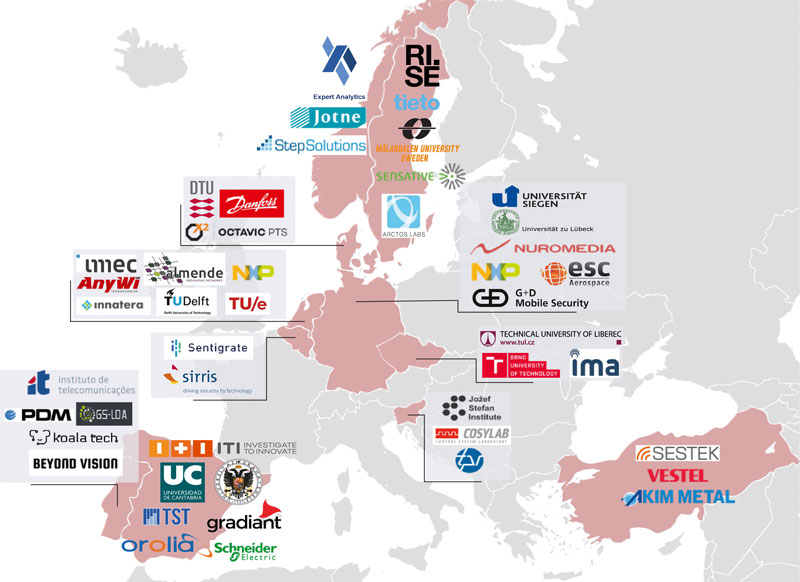by Ali Balador, Sima Sinaei (RISE Research Institute of Sweden) and Mats Pettersson (Sensative AB)
DAIS is a huge step forward in the area of artificial intelligence and edge computing. DAIS intends to create a complete framework for self-organising, energy-efficient and private-by-design distributed AI. DAIS is a European project with a consortium of 47 partners from 11 countries coordinated by Ali Balador from RISE research institute of Sweden.
In recent years, technological developments in consumer electronics and industrial applications have been advancing rapidly. More and smaller, networked devices are able to collect and process data anywhere. This Internet of Things (IoT) is a revolutionary change for many sectors like building, automotive, digital industry, energy, healthcare, etc. As a result, the amount of data being generated at the edge level has and will increase dramatically, resulting in higher network bandwidth requirements. In the meantime, with the emergence of novel applications, such as automated driving, lower latency of the network is required.
The new paradigm of edge computing (EC) provides new solutions by bringing resources closer to the user, keeps sensitive & private data on device, and provides low latency, energy efficiency, and scalability compared to cloud services, while reducing the network bandwidth, in addition bringing cost savings. EC guarantees the quality of service when dealing with a massive amount of data for cloud computing [1,2].
At the same time, Artificial Intelligence (AI) applications based on machine learning (especially deep learning algorithms) are being fuelled by advances in models, processing power, and big data. In Cisco’s annual report (2018-2023) [L1], all 83 organisations asked reported that they have edge computing use cases where artificial intelligence, IoT and 5G had higher portions. The huge increase of devices at the network edge drives the need for enterprises to manage and analyse data from IoT endpoints. Shifting traffic from the network core to the edge affects computing and communications architectures. To have a successful edge computing strategy, it is important to make sure the overall infrastructure is efficient and manageable.
The development of AI applications mostly requires processing of data in centralised cloud locations and hence cannot be used for applications where milliseconds matter, or for safety-critical applications. For example, as the sensors and cameras mounted on an autonomous vehicle generate about a gigabyte of data per second, it is difficult, if not impossible to upload this data and get instructions from the cloud in real-time. The same applies to face recognition applications that have high temporal requirements for processing either online or offline. Moreover, edge computing offers security benefits due to wider data distribution at the edge level. Reducing the distance data has to travel for processing means decreasing the opportunities for trackers and hackers to intercept it during transmission and preserving its privacy. With more data remaining at the edges of the network, central servers are also less likely to become targets for cyberattacks. This has led to a growing interest in Federated Learning (FL), as a promising distributed learning paradigm that allows multiple parties to jointly train a global ML model on their combined data, without any participants having to reveal their data to a centralised server [3].
DAIS is a huge step forward in the area of artificial intelligence and edge computing. DAIS aims at providing edge computing architecture, including both hardware and software, for industrial applications. DAIS is a pan-European effort spanning three years with a total budget of €33 million and a consortium of 47 partners from 11 countries. Coordinated by Ali Balador from RISE, Research Institute of Sweden, and with the support of Europe's industry, Europe's leading research organisations, the European Union via the KDT Joint Undertaking and the participating national funding agencies, it is possible to bring together European and International key players to the benefit of Europe’s economy and society.
DAIS intends to create a complete framework for self-organising, energy efficient and private-by-design distributed AI. The framework covers an end-to-end system consisting of a variety of heterogeneous nodes ranging from simple IoT nodes to high-performance servers and cluster nodes. The framework consists of a hardware framework and a software framework enabling both traditional end-to-end services as well as horizontal systems with multiple service providers using common data, IoT and AI resources. Multiple connected nodes using the DAIS framework creates a complete DAIS system supporting both vertically and horizontally distributed AI. The DAIS framework will also support open standards to interact with other devices, platforms, and services. In DAIS, we leverage existing hardware devices and refine them, as well as develop new devices.
The DAIS SW framework includes a DAIS AI framework, a DAIS security framework, and a DAIS communication framework including SW components, tools, policies, interfaces, and data-models enabling compatibility, privacy, and secure data communication between products and services, creating a fully distributed AI system. The DAIS framework will allow for standardised data pipelines, sharing compute load between nodes, model distribution, as well as model learning hierarchies such as federated learning. Furthermore, it will provide a standardised way of sharing, keeping track of, and distributing model-specific configurations, data and model architectures in a secure manner. The framework is producer-, generator-, vendor- and service-agnostic, hence allowing interaction between the different nodes vertically and horizontally.

Figure 1: The DAIS consortium.
Link:
[L1] https://www.cisco.com/c/en/us/solutions/collateral/executive-perspectives/annual-internet-report/white-paper-c11-741490.html
References:
[1] W. Shi, J. Cao, Q. Zhang, Y. Li, and L. Xu, “Edge Computing: Vision and Challenges,” IEEE Internet of Things Journal, vol. 3, no. 5, pp.637–646, 2016.
[2] Ding, Aaron Yi, et al. "Roadmap for Edge AI: A Dagstuhl Perspective." arXiv preprint arXiv:2112.00616 (2021).
[3] Li, T., Sahu, A. K., Talwalkar, A., & Smith, V. (2020). Federated learning: Challenges, methods, and future directions. IEEE Signal Processing Magazine, 37(3), 50-60.
Please contact:
Ali Balador, RISE Research Institute of Sweden, Sweden











